Unit4 Going Outing(第3课时)
- 格式:docx
- 大小:1.92 MB
- 文档页数:6


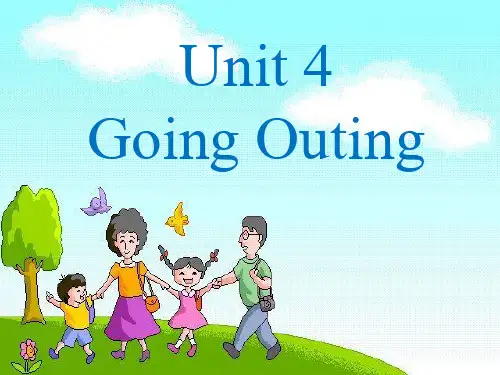
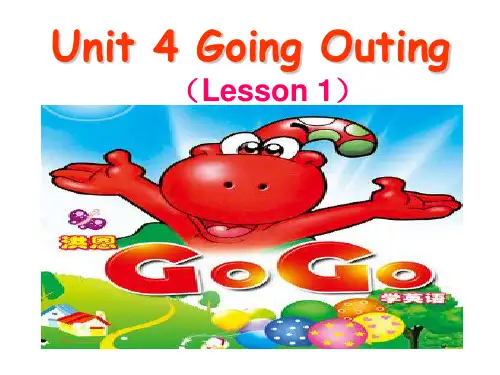
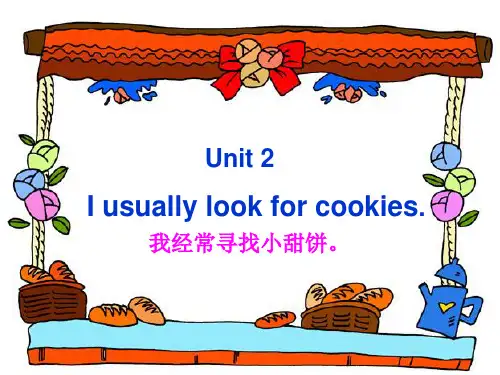
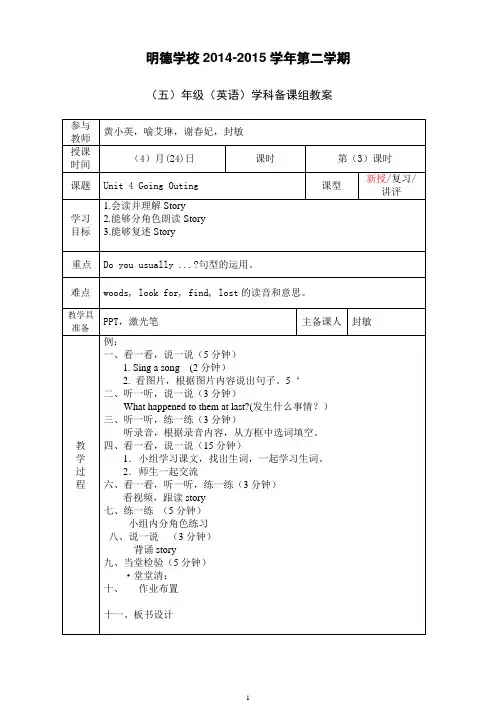
明德学校2014-2015学年第二学期(五)年级(英语)学科备课组教案参与教师黄小英,喻艾琳,谢春妃,封敏授课时间(4)月(24)日课时第(3)课时课题Unit 4 Going Outing 课型新授/复习/讲评学习目标1.会读并理解Story2.能够分角色朗读Story3.能够复述Story重点Do you usually ...?句型的运用。
难点woods, look for, find, lost的读音和意思。
教学具准备PPT,激光笔主备课人封敏教学过程例:一、看一看,说一说(5分钟)1. Sing a song (2分钟)2. 看图片,根据图片内容说出句子。
5‘二、听一听,说一说(3分钟)What happened to them at last?(发生什么事情?)三、听一听,练一练(3分钟)听录音,根据录音内容,从方框中选词填空。
四、看一看,说一说(15分钟)1.小组学习课文,找出生词,一起学习生词。
2.师生一起交流六、看一看,听一听,练一练(3分钟)看视频,跟读story七、练一练(5分钟)小组内分角色练习八、说一说(3分钟)背诵story九、当堂检验(5分钟)·堂堂清:十、作业布置十一、板书设计教学过程 Unit 4 Going Outingwoods, look for, find, lost课堂检测内容课后反思A: What are you doing?B: I'm ______________ my tent.A: Are you going to _______________?B: Yes, Can you help me?A: Sure, When are you going?B: I'm going ____________.A: How are you going?B: Usually I go ____________. But I'm going to __________________this time. A: That sounds great! Look! I____________ it. It's under your bed.。
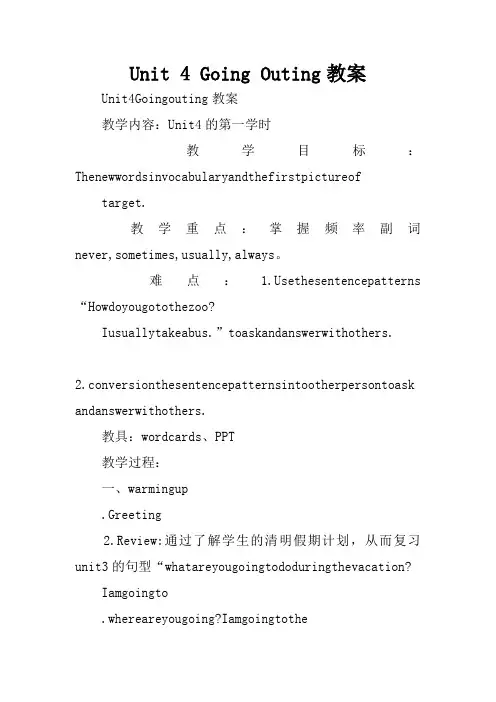
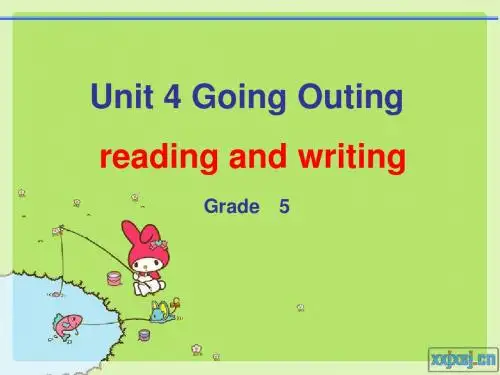
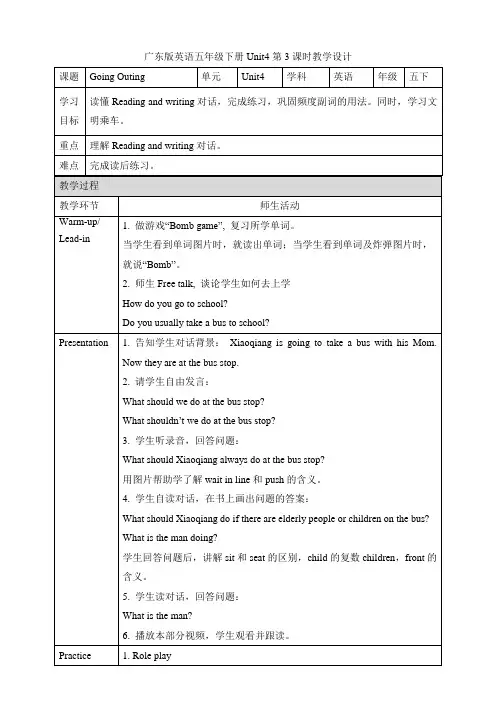
广东版英语五年级下册Unit4第3课时教学设计两人一组,分别扮演妈妈和小强,进行对话吧!2. Write T for true and F for false.学生根据课文内容,判断对错;师生核对答案,同时,请学生把错误的地方改正。
3. Put the words and phrases into the correct column.根据日常生活中的文明守则选词填空。
4. 师生Free talk,引导学生文明出行。
Will you always give your seat to children or old people?Will you cut into the line (插队)?Don’t cut into the line (插队).5. 单项选择。
( ) 1) ______ wait in line for the bus.A. NeverB. SometimesC. Always( ) 2) We should ______ the seat to elderly people on the bus.A. giveB. waitC. take( ) 3) Don’t ______.A. pushingB. pushC. pushes( ) 4) The driver isn’t here ______.A. yetB. eitherC. tooSummarize 今天所学的重点内容有:Now rememb er, always wait in line for the bus, and don’t push.Sometimes there are elderly people or children on the bus. Please give yourseat to these people.Homework 1. 听录音,熟读课文。
2. 预习Sounds and words。
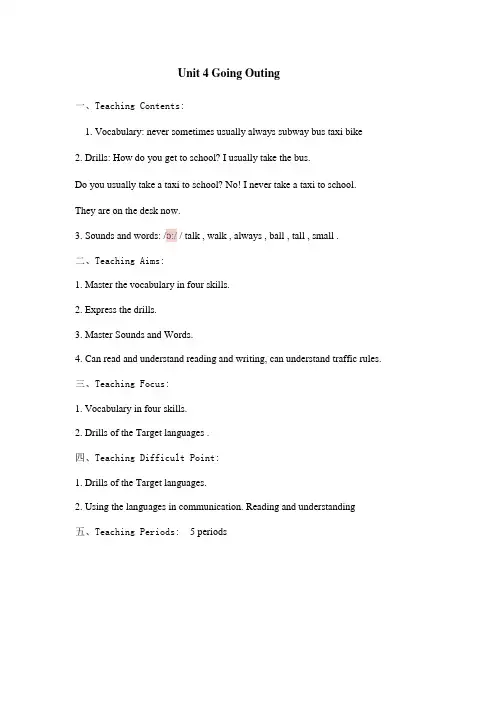
Unit 4 Going Outing一、Teaching Contents:1. Vocabulary: never sometimes usually always subway bus taxi bike2. Drills: How do you get to school? I usually take the bus.Do you usually take a taxi to school? No! I never take a taxi to school. They are on the desk now.3. Sounds and words: /ɔ:/ / talk , walk , always , ball , tall , small .二、Teaching Aims:1. Master the vocabulary in four skills.2. Express the drills.3. Master Sounds and Words.4. Can read and understand reading and writing, can understand traffic rules.三、Teaching Focus:1. Vocabulary in four skills.2. Drills of the Target languages .四、Teaching Difficult Point:1. Drills of the Target languages.2. Using the languages in communication. Reading and understanding五、Teaching Periods: 5 periodsThe 1st Period计划授课时间:Teaching Contents:1. Vocabulary: never sometimes usually always subway bus taxi bike2. Drills: How do you get to school? I usually take the bus.Do you ever take a taxi to school? No! I never take a taxi to school.3. Do Practice 1.Teaching Aims:1. Master the vocabulary in four skills.2. Master the drills in four skills.Teaching focus: vocabulary and drillsTeaching Difficult Point: the drillsTeaching Tools: cards, picturesTeaching procedure:一、RevisionRevise the vehicle we learn in Unit 2 .二、Presentation1. T: How do you get to school?S: I walk to school.T: I usually get to school. ( lead Ss to know “usually”)2. Use the cards to teach the new words .I always ride a bike to school.Lead Ss know the meanings of the new words from the sentences.(After that teach the phrases:take a taxi \take a car\ ride a bike \take a subway)②Write on the board:How do you get to school?I usually take the bus.③ Read together and group by group④Ask and anwser in pairs then check .⑤ T: How does she get to school?S: She usually takes a bus to school.T: Do you ever take a taxi to school?S: No ! I never take a taxi to school.三、Practice 1 (Page 11)四、Consolidation1. Have Ss try to recite the vocabularies2. Listen and repeat the Target .3. Do exercise: Look and writetake a bus take a subway ride a bike walk五、Homework:Copy the new words and sentences.Rev ise the Target六:板书设计:The second period计划授课时间:Teaching Contents: Story , Practice 2 and Song activity .Teaching Aims:1. Master the Story in reading.2. Listening comprehension3. Writing down the vehicle .Teaching focus: Read the Story and answer the questionsTeaching Difficult Point: Talking about : How does sb go to school ?Teaching Tools: cards, tapeTeaching procedure:一、Revision1. Show the cards and revise the words : never , sometimes , usually , always .2. Talking about how to go to school .二、Presentation1. Listen the tape and try to know the story .2. Listen again and find out the new words .3. Teach the new words : woods, look for= find, candy( candies) , lost .4. Listen and repeat .5. Answer the questions :Where are they ? / What are they doing ? / Does Gogo usually find some candies ?6. Role reading .7. Try to use the key words to complete the story , then check .三、Practice 21. T give out an example : How does Jenny go to school ? She usually take a bus .2. Have Ss ask and answer in group .四、Song activity : Listen , write and sing .五、HomeworkCopy and recite the Story .板书设计:The third period计划授课时间:Teaching Contents: Sounds and words and Activity .Teaching Aims:1. Master the sound/ɔ:/ / talk , walk , always , ball , tall , small .2. Can reading the chantTeaching focus:1. Sounds and words /ɔ:/ / talk , walk , always , ball , tall , small .2. Reading sentencesTeaching Difficult Point: List the other wordsTeaching Tools: radioTeaching Procedure:一、Revision1、Retell the story .2、Ask and answer questions .二、Activity1、The teacher give out an example .2、Let Ss ask , answer and draw .3、Ask someone to show the result .三、Sounds and Words1、Have read the words corretly and think of their same sound.2、Tell Ss “al” usually prounuce /ɔ:/ / .3、Read after the tape .4、L ook at the teacher’s mouth and guess the words.5、Say more words that have /ɔ:/ / , such as : fall , baseball , basketnall , all ect.四、Listen and chant1、Read the chant loudly .2、Chant after the tape for three times.3、Chant it by themselves .五、Homework:Read the words and copy Activity六、板书设计:The fourth period计划授课时间:Teaching Contents: Reading and writing.Teaching Aims:1、Master the main content of Reading and writing.2、Do the practice .Teaching focus: Read the Story and do the practiceTeaching Difficult Point:Talking about how to do Reading and writing.Teaching Tools: radioTeaching Procedure:一、Revision1.Revise the sound of “al” and read the words in Sounds and words .2. Chant .二、 Presentation1、Look, listen and read ,then answer: Where are Xiaoqiang and his mother? What should Xiaoqiang remember ?2、Listen and check the answer .3、Lead Ss try to know the dialogue .4、Do the exercise 2 : Read again and write T for true and F for false.5、Check the answer.6、Do the exercise 3 : Read the words and phrases ,then put them ioto the correct column .三、Practice1、Read the dialogue .2、Listen to the tape and repeat.3、Try to understand the main content of the dialogue.四、Sum up五、Homework: Read the dialogue and copy the words and phrases in exercise 3.六、板书设计:The 5th Period计划授课时间:Teaching Contents: More reading and writingTeaching Aims:1、Master the main content of the more reading and writing.2、Do the practiceTeaching focus: Read the sentences and do the practiceTeaching Difficult Point:Talking about how to do the More reading and writing. Teaching Tools: pictures , radioTeaching Procedure:一、RevisionShow the pictures and revise the vehicle .二、Presentation and Practice1、T: There are different names for the subway all over the world . Today let’s see what they are .2、Look, listen and read for twice .3、Try to finish Exercise 2 .4、Help Ss to know the meaning of the short passages.5、Listen and repeat .6、Check the answer for Exercise 2 .7、Look and match .8、Teach the new names of the vehicle in Exercise 49、Look at the pictures . Match them with the words below .三、Sum up四、Homework: Read the passages.五、板书设计:教学反思:第一课时教学目标1.复习1~3单元的四会单词和短语:play ping-pong, go swimming, pick apples, go shopping, play basketball, go on a picnic, go to work, eat breakfast, eat lunch, eat dinner, cook dinner, go to bed。

Unit4 Going Outing第3课时习题一、根据课文内容,选择正确的答案。
1. Xiaoqiang and his Mom are at the ________.A. bus stopB. home2. Remember ________ wait in line.A. neverB. always3. Please give seat to _________ people.A. youngerB. elderly4. The man is pushing to the ________ of the line.A. frontB. behind5. The man is the ________.A. driverB. passenger (乘客)二、情景交际。
( ) 1. 当你想打断别人的话时,你可以说:A. Sorry.B. Excuse me.( ) 2. 在公交车站等车时,有人没按顺序排队,你应该说:A. Please wait in line.B. Please cut in line.( ) 3. 体育课上,有同学在推挤,你应该说:A. Don’t push.B. Don’t run.( ) 4. 公园到了,你可以说:A. Here is the zoo.B. Here is the park.三、根据要求完成句子。
1. I always go to school by bus. (就划线部分提问)________________________________________________2. They take a taxi to the zoo. (改为一般疑问句时)________________________________________________3. She find some books in the room. (改为否定句)________________________________________________4. are, there, sometimes, on, bus, children, the, (.) (连词成句)________________________________________________5. Do you always watch TV in the evening? (给出否定回答)________________________________________________四、阅读理解。
备课教师时间课题Unit 4 Going Outing教学目标知识与技能1. 学会Vocabulary 的4个频率副词和4种交通工具。
2. 学习Target。
3. 学会歌曲Every day I take the bus过程与方法通过介绍Tony,Jenny,Gogo和Ben如何上学引出新词。
情感态度和价值观让学生使用频率副词描述自己的生活。
教学重点Vocabulary 的4个频率副词:never ,sometimes,usually ,always,和4种交通工具:subway, a car, a taxi, a bike。
教学难点频率副词的使用教具准备PPT 课时 1教学过程备注I.Warm-up1. Free talk :T: How do you go to school?S1: …….II. Presentation (Page 47)1.T:Gogo never takes a subway to school.(教学never和subway)2.T:Jenny sometimes takes a car to school.(教学sometimes和a car)3.T:Tony usually takes a taxi to school.(教学usually和a taxi)4.T:Ben always rides a bike to school.(教学always和a bike)5.Ss follow the tape to read all the words.6. T:Now talk about how you go to school with your deskmate.III. Practice (Page 47)1. T: How does Tony get to school? Does he ever take a taxi toschool?Let’s listen to the tape, then answer my questions.2. Let’s listen to the tape.3. Have some Ss to answer my questions.4. Ss read after the tape.5. Ss practice the dialogue, then read together.IV. Chant activity (Page 52)1.Ask the Ss to listen to the song:Every day I take the bus2. Ss follow the tape to sing the song.3. After practicing several times,Ss sing together.4. Ask the Ss to finish the lyrics.5. Check the lyrics.V. Homework1.Copy the vocabularies.2. Read the Target.板书设计Unit 4 Going Outing4个频率副词:never ,sometimes,usually ,always,4种交通工具:subway,a car,a taxi,a bike教学反思备课教师时间课题Unit 4 Going Outing教学目标知识与技能 1.学会Story的对话。
Unit4 Going Outing(第3课时)
教学过程:
Step 1 Lead-in (6 mins)
1. Free talk: Good afternoon! Boys and girls. Are you sleepy? Do you want to sleep?
2. Game:Simon says. Emphasize the rules of Simon says.
Guess and think: What are the rules for this class.
(设计意图:通过问题引导师生关注学习状态,并且以游戏的形式破冰进行读前活动,Simon says 的设计激活学生旧知和联结学生的新知,让学生在轻松愉悦地氛围中自然学习。
如:run, walk, jump, sing, dance, shout, wait, push…)
Step 2 Before reading (4 mins)
Talk and guess: How do you usually go to school? How does your teacher go to school?(listen to the song and guess)
Watch and think: The teacher saw some students at the bus stop. What things you can or can’t do at the bus stop?
(设计意图:通过谈论师生每天乘坐什么交通工具上学引出老师在公交车站候车的见闻,学生边观看老师录制的视频边思考哪些行为可行哪些不可行,小组讨论鼓励
学生用英语分享。
)
Step 3 While reading. (10mins ) 图片环游
1.Watch a video: Guess and think (Where are they? What are they talking about. )
2.Guess and talk: What is your mom going to say when you take a bus.
Use scanning to find out the answer.
Guess and learn: The meaning of remember.
Act and learn: wait in line, don’t push.
3.Guess and talk: If you are Xiaoqiang, what would you say? What is Xiaoqiang
going to say?
4.View and guess: Look at the picture, discuss in group.(who? What to do?)
5.Read and learn: More signs at the bus stop or on the bus from Canada.
6.Guess and think: What is the man doing? What is mom going to do or say?
7.Read and imitate: A. HEY! You should wait in line. B. Excuse me, please wait in
line. Which is better and polite?
8.Read and scan: Find out the answers through reading.
(设计意图:1.由于教材文本插图较单一缺乏趣味性,特将文本整合成漫画式的故事呈现,学生把人物角色的画像设计成《小屁孩日记》中的主人公形象,很好地激发了学习的兴趣和增加语言学习的趣味性。
教师通过图片环游的形式引导学生看图思考和预测人物的语言以此推断故事情节的发展,同时促进学生思维品质的培养。
2.在学前教师借助现代信息技术手段录制视频,编辑文本与漫画插图的视频,帮助
学生学前了解学习内容,引导学生使用英语表达生活中所见所闻。
3.在学习过程中,学生思考老师所提出的问题,在解决问题中学习语言并运用阅读策略读懂文本和获取信息。
)
Step 4 Practice (10 mins)
Have students to read and act out the story in groups.
(设计意图:通过漫画的提示来演绎故事,不仅促进学生感知和运用语言于情境而
且还提升了学生合作交流的交际策略。
Step 5. After reading. (8 mins)
Think, talk, draw and write: Design a sign for taking bus. Guide others to do the right things on the bus or at the bus stop. For example:
Tips:①Four students work in one group.
②Discuss what to write and what to draw.
③Share and report your design in class.
(设计意图:读后学生小组合作设计乘车“温馨提示”标牌,通过画相关标志和写提示语对学生进行评价,评价学生对本节课目标语言的掌握,对英语语言国家标示牌的了解,对乘车礼仪的认知等。
根据项目式学习的理念,学生设计和制作标示牌的过程不仅有利于其语言学习和交际,而且还利于促进学生思维能力的培养。
)
Step 6 Summary and homework (2 minutes)
1. Summary
Think: Do you usually wait in line for the bus?
(设计意图:通过图片引导学生反思自己平时是否能够文明出行,引导学生在不同的。